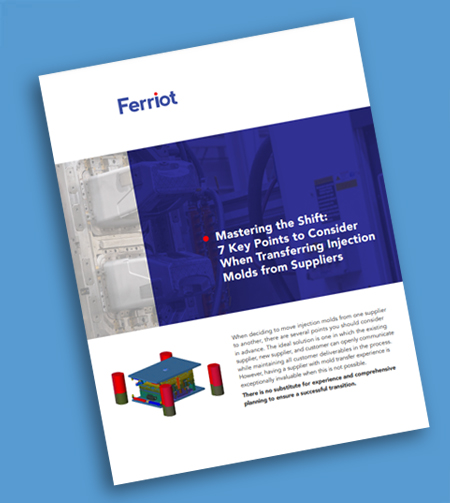Choosing the right plastic resin is one of the most critical decisions in any injection molding project. While technical resources like Ferriot’s Injection Molding Resin Selection Workbook provide valuable guidance, the reality is that successful material selection goes well beyond datasheets and mechanical specs. In fact, the material you choose influences nearly every aspect of the project. From mold design and cycle times to regulatory compliance and assembly methods, resin selection directly impacts product quality, manufacturability, and overall cost. In other words, it’s not just a design input; it’s a strategic decision. That’s why we’re going beyond the injection molding material selection guide.
For OEMs in demanding industries like medical devices, business equipment, industrial systems, and electronics, overlooking the broader implications of resin selection can lead to compromised performance or missed opportunities to reduce production time and cost.
In this article, we’ll explore how resin selection shapes downstream decisions across the injection molding process and how Ferriot helps OEMs align material choices with their engineering goals and product requirements.
The Real-World Impacts of Resin Choice Beyond the Injection Molding Material Selection Guide
Material properties such as strength, flexibility, heat tolerance, and chemical resistance directly affect how a part performs in real-world applications. Will the component experience impact, stress, or exposure to harsh environments? The answers determine which thermoplastics are viable.
Selecting the wrong material can lead to brittleness, warping, or early failure. For example, a resin lacking impact resistance may not hold up in a part with snap fits or living hinges. Conversely, using a premium resin when a standard-grade material would suffice can inflate costs unnecessarily.
OEMs must often balance trade-offs: performance vs. cost, or aesthetics vs. structural needs. Choosing the right resin upfront affects not only how a product functions but also its durability, warranty exposure, and long-term success.
Collaboration is Key: Why Your Molder Should Be Involved Early
Because resin selection is rarely straightforward, involving your injection molder early in the process is critical. Ferriot collaborates with OEMs from the start to ensure the selected material aligns with the design, function, and manufacturing goals.
Our team considers end-use conditions, compliance requirements, and part complexity to recommend the best-fit resin, whether for business machines, medical housings, or industrial components. We combine material expertise with mold flow simulation, DFM analysis, and, if needed, prototyping to flag issues before tooling begins.
Ferriot’s real value comes from context-driven insight. We assess how materials will perform in your specific application, reducing risk and helping you move from design to production with confidence.
Regulatory, Compliance, and Sustainability Considerations
In regulated industries, resin selection must meet stringent compliance standards, not just technical specs. Depending on the application, materials may need to meet:
- UL certifications for flame retardance and electrical safety
- FDA or ISO standards for medical or food-grade use
- REACH/RoHS directives for environmental safety
- Low-outgassing requirements for sensitive electronics
Ferriot helps OEMs navigate these regulatory demands and select certified resins that won’t create delays or compliance issues. We also support sustainability goals by advising on options such as recycled-content materials, bio-based polymers, or resins that align with circular design strategies.
Resin Selection in Context: What the Guide Can’t Tell You
The “best” resin isn’t always the one with the strongest specs. Application context like wall thickness, surface finish, part complexity, or downstream finishing can all influence what’s suitable.
Some materials flow better for intricate geometries. Others resist shrinkage or perform better under ultrasonic welding or heat staking. Decorative processes like painting or pad printing also require surface compatibility, which not all resins provide.
That’s why Ferriot’s Injection Molding Material Selection Guide is a valuable first step, but not a final answer. Choosing the right material depends on part-specific demands, and that’s where our experience helps translate theory into successful production.
Work with Ferriot to Make the Right Material Decision
While injection molding material selection guides are a valuable starting point, they can’t account for the full range of factors that impact your part’s success. From manufacturability and compliance to real-world performance and cost control, choosing the right thermoplastic requires a strategic, application-specific approach.
That’s where Ferriot adds measurable value. With decades of experience, deep materials knowledge, and in-house engineering support, we help OEMs make informed decisions that align with both technical requirements and business goals. Whether you’re launching a new product or re-evaluating an existing one, our collaborative process ensures your resin choice supports long-term performance, efficiency, and market success.
Already reviewing our material selection guide but want experienced input? Contact Ferriot today to align your resin decision with your performance and production goals.



